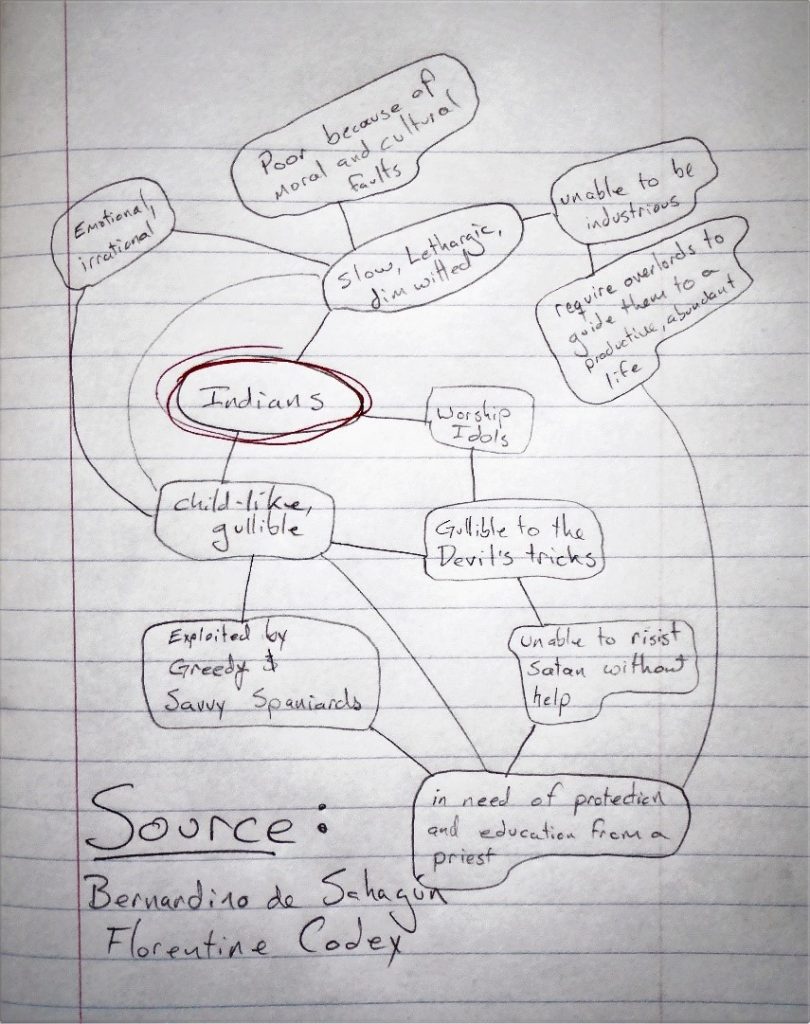Interpreting Your Source
For Empire’s Progeny, there are two broad research questions that should inform how you interpret your source:
1) What racial ideas or categories existed in the Spanish and Portuguese empires in ____ place and ____ time? What these categories mean and how did they support the projects of imperialism and slavery?
2) How did the specific context of your source shape the way race worked in practice in that time and place?
These are our guiding questions. Keep both in mind as you are approaching your source. When it comes to writing your essay, it is probable that you will want to focus one or the other.
A little elaboration on our research questions
Question 1

The first question is the simpler one. As we have discussed in class, our goal is to set aside our present-day assumptions about what race means or meant and instead to understand how people in the past saw it.
Begin by collecting all of the racial terms used in the source, but also tease out those that the creator assumed but left unsaid. For instance, the picture to the right spells out some of the ideas of a 16th century friar. He didn’t say it, but he clearly thought Spaniards were rational, mature, and intelligent in contrast to his portrayal of Indians.
Then gather together the said and unsaid traits and implications that the source connects to each identity marker and think carefully about how these were supposed to relate with one another. It might work best to draw and chart the ideas, as you see to the right.
Finally, attempt to deduce the logic or central elements of the stereotype. In the example above, it is clear that the friar’s central point was that Indians require the protection and guidance of a well-intended religious authority.
Question 2
This question is a bit more challenging.
European empires were all founded upon racial ideologies that legitimized imperialism and structured imperial power. Europeans devised various ways of claiming superiority and arguing that their empires were righteous and good. Race also shaped imperialism in very concrete ways: it was built into the legal system, urban infrastructure, religious practice, domestic life, commerce, and more. Through these structures and the practices of everyday racism, race indelibly shaped everyone’s lives.
This varied greatly. A peasant farmer perhaps experienced socioracial categories only on market days or during very occasional legal transactions; most of the time, working in the fields and caring for his family, race was probably far from his mind. On the other hand, an indigenous woman who worked as a servant for a rich family likely experienced racial discrimination every day, all day long, in countless ways. An enslaved African on a plantation experienced race in every facet of his life and felt it in his gut and on his back. An unconquered Apache (Ndé) in Texas, however, experienced race through the race-hatred and fear of Spanish soldiers who believed that the only way to deal with the Apache was to kill them all.
Significant events could change the situation as well. After an earthquake, in the wake of a bread riot, or during an invasion by the British, racial categories could become less rigid, or perhaps more so, as people adapted and acted in novel ways. We are trying to understand where and when these identity designations mattered and how.
As you read and re-read your source, think about whose experience the source lets you see. Sometimes there may be more than one way to read the source. Imagine, for instance, a priest’s account of the legal troubles of an indigenous man. This account probably reveals the assumptions and ideas of the priest: the contours of his racism, how he thought that proper religious instruction was necessary to reform Indian habits and culture, the sense of personal mission he got from this. On the other hand, if we think that the priest’s account was more-or-less accurate, it might contain revelations for us about how native people experienced and navigated the racial strictures built into the legal system.
Finally, a special interest of ours this semester is how notions of gender and sexuality shaped racial ideas and experiences and vice versa. As we will discuss in depth in class, the racial ideologies of the Iberian empires were deeply integrated with the control of gender identities and sexuality. The most pronounced way was through the control of young women’s bodies. Patriarchy in the empires was foremost about surveilling and regulating women’s sexuality so as to prevent racial mixing and protect the honor of the family name. The church, the colonial government, and family patriarchs all worked together to police women’s bodies. But this wasn’t the only way that race, gender, and sexuality were intertwined. For example, a man persecuted by the church for prohibited sexual practices faced very different outcomes depending on his perceived racial identity. Not all of our sources will be revelatory regarding this matrix, but if it is there, pay attention to how racial discrimination worked through gender norms and the regulation of sex.